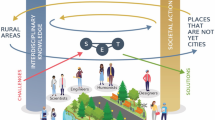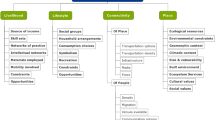Abstract
We explore the construction of community meaning on an emerging amenity landscape in the western United States through in-depth interviews and ethnographic fieldwork with residents of rural Fremont County, Colorado. The meanings ascribed to community center on different interpretations of home, social interaction, and personal identity. Although in some cases these differences correspond to the conventional division between new and long-term residents, the more significant finding was a discourse of “co-opetition” that captures a broader countywide understanding of community as simultaneous cooperation and competition among local stakeholders. Ultimately, this conceptualization of rural community is a way of negotiating the form and function of the amenity landscape. The production of meaningful social interaction points to opportunities for engaging residents in land management as they interact with one another and the landscape.

Similar content being viewed by others
Notes
In this region, the practice of transhumance was vertical and involved wintering cattle on private land in the valleys and transporting the animals to summer pasture, typically on public lands, in the higher elevations.
The principal author spent 2 months in residence each summer over 5 years; the second author spent 2 months in residence in 2008. The field camp students were in the valley for 3 weeks near the end of each summer. The interviews were recorded digitally and subsequently transcribed. At the close of each discussion, interviewees were thanked, given a gift card for a complementary drink at a Cañon City coffee shop, and invited to a barbecue at the field camp near the end of the summer field course in August. Following each interview, a post-interview reflection was completed noting observations on the setting, quality of interaction, and any other impressions not captured by the digital recording or interviewer notes.
These interviews were conducted with employees from the Bureau of Land Management, Natural Resources Conservation Service, Office of Fremont County, US and State of Colorado Forest Service, Royal Gorge History Center, and the Winery at The Abbey in Cañon City.
Grounded codes are the themes and patterns that emerge from an immersive, inductive reading of the interviews. Often, the phrasing or description used to define the code comes directly from a particularly perceptive participant response that effectively characterizes other, similar responses in the data set.
Total interviews in which the participant talked about community in terms of the volume and quality of local social interactions: for residents with 20 or more years: 15/15; for residents with less than 20 years: 87/98.
The right to use surface water is administered by the State of Colorado. A rancher holding a water right may choose to sell that asset along with the property when subdivision occurs, although the two remain separate pieces of property. Consequently, a few households (or a single household) can own water rights to the local stream. Sometimes, the new owners may fail to use their water allocation, which violates state law concerning “beneficial use.” Seven subdivisions in the county have developed Conservation Plans with the local conservation district, in some instances because it satisfies this requirement of state water law.
References
Agrawal, A., & Gibson, C. (1999). Enchantment and disenchantment: The role of community in natural resource conservation. World Development, 27(4), 629–649.
Barabási, A.-L. (2003). Scale-free networks. Scientific American, 288(5), 60–69.
Boucquet, N., Campbell, L., Cumming, G., Meletis, Z., Norwood, C., & Stoll, J. (2011). Interpreting amenities, envisioning the future: Common ground and conflict in North Carolina’s rural coastal communities. GeoJournal. doi:10.1007/s10708-010-9387-1.
Bradshaw, T. K. (2008). The post-place community: Contributions to the debate about the definition of community. Community Development: Journal of the Community Development Society, 39(1), 5–16.
Brogdon, M., & Greenberg, J. (2003). The fight for the West: A political ecology of land use conflicts in Arizona. Human Organization, 62(3), 289–298.
Cadieux, K. (2011). Competing discourses of nature in exurbia. GeoJournal. doi:10.1007/s10708-009-9299-0.
Cadieux, K., & Hurley, P. (2011). Amenity migration, exurbia, and emerging rural landscapes: Global natural amenity as place and process. Geojournal. doi:10.1007/s10708-009-9335-0.
Charnley, S., McLain, R., & Donoghue, E. (2008). Forest management policy, amenity migration, and community well-being in the American West: Reflections from the Northwest Forest Plan. Human Ecology, 36(5), 743–761.
Cosgrove, D. (1989). Geography is everywhere: Culture and symbolism in human landscapes. In D. Gregory & R. Walford (Eds.), Horizons in human geography (pp. 118–135). London: Macmillan.
Delanty, G. (2003). Community. London: Routledge.
Domahidy, M. (2003). Using theory to frame community and practice. Journal of the Community Development Society, 34(1), 75–84.
Flora, C. B., & Flora, J. L. (2008). Rural communities: Legacy and change (3rd ed.). Boulder, CO: Westview Press.
Fortmann, L., & Kusel, J. (1990). New voices, old beliefs: Forest environmentalism among new and long-standing rural residents. Rural Sociology, 55(2), 214–232.
Glaser, B., & Strauss, A. (1967). The discovery of grounded theory: Strategies for qualitative research. Chicago: Aldine Publishing Company.
Gosnell, H., & Abrams, J. (2009). Amenity migration: Diverse conceptualizations of drivers, socioeconomic dimensions and emerging challenges. Geojournal. doi 10.1007/S10708-009-0205-4.
Gosnell, H., Haggerty, J. H., & Travis, W. R. (2006). Ranchland ownership change in the Greater Yellowstone Ecosystem, 1990–2001: Implications for conservation. Society & Natural Resources: An International Journal, 19(8), 743–758.
Grieder, T., & Garkovich, L. (1994). Landscapes: The social construction of nature and the environment. Rural Sociology, 59(1), 1–24.
Harper, S. (1987). A humanistic approach to the study of rural populations. Journal of Rural Studies, 3(4), 309–319.
Hecht, S. (2004). Invisible forests: The political ecology of forest resurgence in El Salvador. In R. Peet & M. Watts (Eds.), Liberation ecologies: Environment, development, social movements (2nd ed., pp. 64–104). New York, NY: Routledge.
Hurley, P., & Halfacre, A. (2011). Dodging alligators, rattlesnakes, and backyard docks: A political ecology of sweetgrass basket-making and conservation in the South Carolina Lowcountry, USA. GeoJournal. doi:10.1007/s10708-009-9276-7.
Johnson, W., McMaster, R., & Sorenson, C. (1980). Changing ranchland usage in Garden Park, Colorado. Great Plains-Rocky Mountain Geographical Journal, 9(1), 59–71.
Jones, R., Fly, J., Talley, J., & Cordell, H. (2003). Green migration into rural America: The new frontier of environmentalism? Society & Natural Resources, 16(3), 221–238.
Kaup, B. Z. (2008). The reflexive producer: The influence of farmer knowledge upon the use of Bt Corn. Rural Sociology, 73(1), 62–81.
Knight, R., Smith, F., Buskirk, S., Romme, W., & Baker, W. (Eds.). (2000). Forest fragmentation in the Southern Rocky Mountains. Boulder: University Press of Colorado.
Larsen, S. C. (2004). Place identity in a resource-dependent area of northern British Columbia. Annals of the Association of American Geographers, 94(4), 944–960.
Larsen, S. C., Foulkes, M., Sorenson, C., & Thompson, A. (2010). Environmental learning and the social construction of an exurban landscape in Fremont County, Colorado. Geoforum, 42(1), 83–93.
Ley, D. (1983). A social geography of the city. New York: Harper and Row.
Littrell, D. W., & Littrell, D. P. (2006). Practicing community development. Columbia, MO: University of Missouri Extension.
Matarrita-Cascante, D., & Luloff, A. (2008). Profiling participative residents in Western communities. Rural Sociology, 73(1), 44–61.
McCarthy, J. (2008). Rural geography: Globalizing the countryside. Progress in Human Geography, 32(1), 129–137.
McCormick, K. (1998). Home, home on the ranchette. Planning, 64(2), 4–8.
Mitchell, D. (2000). Cultural geography: A critical introduction. Oxford: Blackwell.
Moss, L. (2006). The amenity migrants: Seeking and sustaining mountains and their cultures. Wallingford: CABI.
Park, D., & Coppack, P. (2004). The role of rural sentiment and vernacular landscapes in contriving a sense of place within the city’s countryside. Geografiska Annaler B, 76(3), 161–172.
Purdy, J. (1999). The new culture of rural America. American Prospect, 11(3), 26–31.
Robbins, P. (2006). The politics of barstool biology: Environmental knowledge and power in greater Northern Yellowstone. Geoforum, 37(2), 185–199.
Romme, W. H. (1997). Creating pseudo-rural landscapes in the Mountain West. In J. Nassauer (Ed.), Placing nature: Culture and landscape ecology (pp. 141–161). Washington, DC: Island Press.
Schnell, S., Sorenson, C., Larsen, S. C., Dunbar, M., & McGrogan, E. (2004). Old West and New West in Garden Park, Colorado. Montana: The Magazine of Western History, 54(4), 32–47.
Scott, A., Shorten, J., Owen, R., & Owen, I. (2011). What kind of countryside do the public want: Community visions from Wales UK? GeoJournal. doi:10.1007/s10708-009-9256-y.
Sheridan, T. E. (2001). Cows, condos, and the contested commons: The political ecology of ranching on the Arizona-Sonora borderlands. Human Organization, 60(2), 141–152.
Shibutani, T. (1961). Society and personality: An interactionist approach to social psychology. Englewood Cliffs, NJ: Prentice-Hall.
Spain, D. (1993). ‘Been-heres’ and ‘come-heres’: Negotiating conflicting community identities. Journal of the American Planning Association, 59(2), 156–171.
St. Martin, K. (2005). Mapping economic diversity in the First World: The case of fisheries. Geoforum, 37(1), 169–184.
Taylor, L. (2011). No boundaries: Exurbia and the study of contemporary urban dispersion. GeoJournal. doi: 10.1007/s10708-009-9300-y.
Walker, P. (2003). Reconsidering ‘regional’ political ecologies: Toward a political ecology of the rural American West. Progress in Human Geography, 27(1), 7–24.
Walker, P., & Fortmann, L. (2003). Whose landscape? A political ecology of the ‘exurban’ Sierra. Cultural Geographies, 10(4), 469–491.
Yin, R. K. (2003). Case study research design and methods (3rd ed.). Thousand Oaks, CA: Sage Publications.
Acknowledgments
The research presented here was funded by a grant from the National Science Foundation Geography & Regional Science Division (Grant #0752183). We would like to thank Terry Slocum, Chair of the Department of Geography at the University of Kansas, for supporting the collaborative research endeavor that made this project possible, as well as the residents and natural-resource professionals of Fremont County, Colorado, who gave us their time and perspectives on the topic of environmental learning. Finally, this research would not have been possible without the time and energy invested by students at the University of Kansas Geography Field Camp who enrolled or participated in the “Field Experience” course during the summers of 2008 and 2009: Andrew Allen, Robbie Anderson, Emmanuel Birdling, Lesley Clark, Stephanie Day, Jared Doke, David Fox, Keith French, Erin Garity, Jessica Garrett, Aaron Gilbreath, Jessey Gilley, Cara Haas, Katie Haselwood, Hilary Hungerford, Lauren James, Mike Loader, Stephanie Meador, Lisa McKinney, Andrew Norris, John Oakes, Emily Pabst, Matt Petrie, Tanner Popp, Nicole Reiz, Evie Schlife, Andrew Sherman, Luke Struckman, Austin Thelen, Zach Tuthill, Travis White, Paula Smith, Henry Shiu, Eric Weber, and Joe Wimmer.
Author information
Authors and Affiliations
Corresponding author
Rights and permissions
About this article
Cite this article
Larsen, S., Hutton, C. Community discourse and the emerging amenity landscapes of the rural American West. GeoJournal 77, 651–665 (2012). https://doi.org/10.1007/s10708-011-9410-1
Published:
Issue Date:
DOI: https://doi.org/10.1007/s10708-011-9410-1




